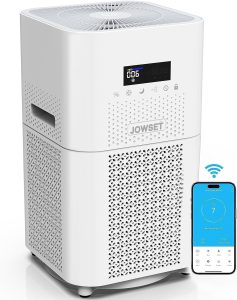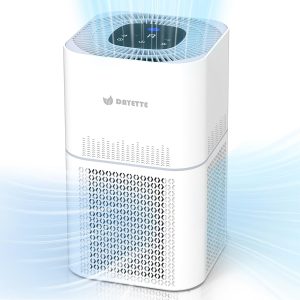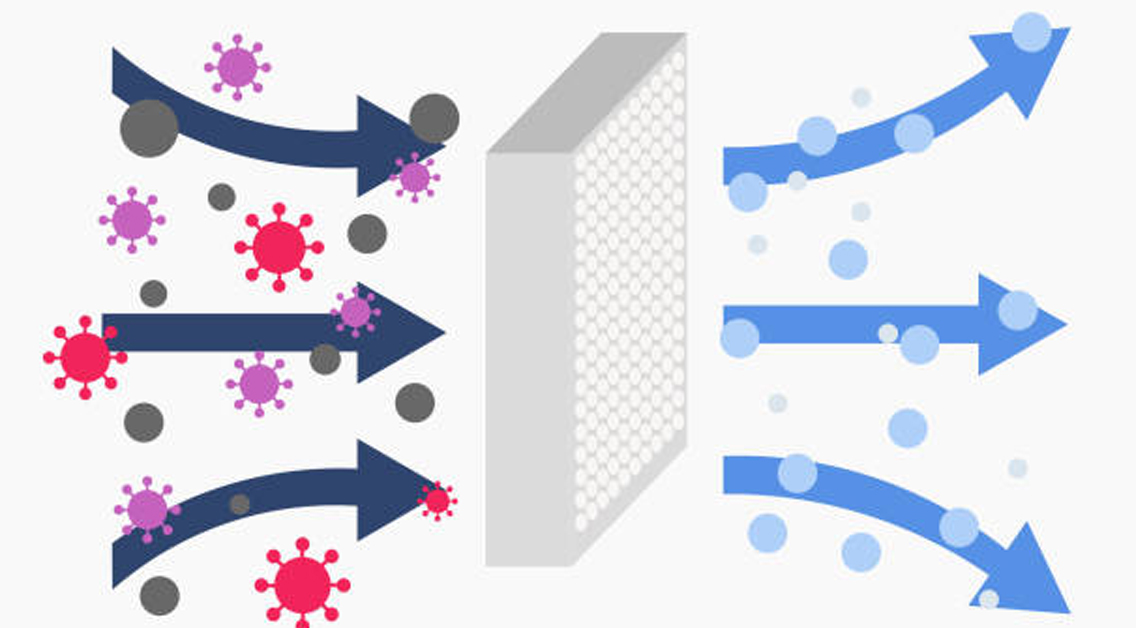Question is “How Do Home Air Purifiers Work”. You will discover more about the inner workings of home air purifiers in this post. You’ll learn how these gadgets assist create a healthier atmosphere for you and your family by enhancing the air quality in your house.
Home air purifiers function by eliminating allergens and pollutants from the air that could be damaging to your health. To capture and trap particles including dust, pet dander, smoke, and mold spores, they often use a combination of filters, such as a pre-filter, HEPA filter, and activated carbon filter. The air you breathe becomes cleaner and more hygienic as a result of these filters’ efficient removal of harmful contaminants. Others employ UV-C light technology to destroy viruses and germs in the air. In general, home air purifiers diligently work to enhance the quality of your indoor air and encourage a better living environment.
Introduction
What are home air purifiers?
Devices that purify the air in your house are known as home air purifiers. They function by eliminating odors, allergens, and pollutants from the air, giving you and your family a clean, fresh atmosphere to breathe in.
Importance of air quality in homes
Our general health and well-being are significantly impacted by air quality. Numerous health problems, such as allergies, respiratory disorders, and even chronic illnesses, can be brought on by poor indoor air quality. It has become imperative to take action to enhance the air quality in our homes due to the growth in pollution levels and the quantity of allergens in the atmosphere.
Types of Home Air Purifiers
HEPA filters
Air purifiers frequently employ HEPA, or High-Efficiency Particulate Air, filters. Small particles like dust, pet dander, pollen, and even tobacco smoke are all captured by these filters. HEPA filters function by pushing air through a tiny mesh that captures these particles, preventing their recirculation.
Activated carbon filters
Filters made of activated carbon are very good in eliminating pollutants, chemicals, and odors from the air. A unique sort of carbon that has been treated to boost its absorbency is present in these filters. The odors and chemicals in the air are drawn to the carbon surface and retained there as it passes through the carbon filter, making the air cleaner and fresher.
Ionic generators
Ionizers, commonly referred to as ionic generators, produce negatively charged ions that are released into the atmosphere. These negatively charged ions bind to positively charged particles like dust, pollen, and smoke, making them too heavy to remain in the atmosphere. By successfully removing these particles from the air, a process known as ionization results in a healthier environment.
UV light purifiers
Airborne bacteria, viruses, and other organisms are neutralized and killed by UV light purifiers. By exposing the air to UV-C light, these air purifiers destroy the DNA of these dangerous organisms and stop them from reproducing. Particularly efficient at halting the transmission of airborne diseases are UV light purifiers.

Working Principles
HEPA filters capture particles
Many air purifiers are built around HEPA filters. With a 99.97% efficiency, they work by catching particles as small as 0.3 microns. These particles are kept from being discharged back into the air by the filter, which traps them in its fibers. Because of this, HEPA filters are very effective at eliminating typical allergens including dust mites, pet dander, and pollen.
Activated carbon filters absorb odors and chemicals
When it comes to eliminating odors and pollutants from the air, activated carbon filters shine. The carbon has been treated to improve its porous structure, which enables it to absorb a variety of gases and chemicals. This makes it extremely efficient in getting rid of offensive odors like cooking odors, tobacco smoke, and volatile organic compounds (VOCs) released by furniture and cleaning supplies.
Ionic generators produce negative ions to neutralize pollutants
Negative ions are released into the atmosphere by ionic generators. Positively charged particles clump together and fall out of the air when these ions bind to them. By removing them, substances like smoke, pollen, and dust have a lower concentration in the space. It’s crucial to keep in mind that some ionizers have a limited but potential for dangerous ozone production in high doses.
UV light purifiers kill bacteria and viruses
UV light purifiers destroy bacteria, viruses, and other organisms in the air by using ultraviolet light. These purifiers’ UV-C light destroys the DNA of the germs, preventing them from reproducing or spreading infection. Because of this, UV light purifiers are very successful at limiting the transmission of airborne diseases, particularly in places with a lot of microbial activity.
Features and Benefits
Improved air quality
Air quality improvement is the main advantage of utilizing an air purifier at home. These gadgets make your home healthier and more comfortable for you and your family by removing allergens, pollutants, and odors from the air. Inhaling clean air can help lessen the effects of allergies, asthma, and other respiratory conditions, improving overall health.
Reduced allergies and respiratory issues
For people with allergies or respiratory issues, home air purifiers are very beneficial. Pollen, pet dander, and dust mite allergens are effectively captured by HEPA and activated carbon filters, which lessens exposure to these potential asthma or allergy triggers. This may result in a significant decrease in symptoms and an enhancement of quality of life.
Elimination of odors
The removal of offensive odors is one of the obvious advantages of using an air purifier with activated carbon filters. These filters may efficiently absorb and retain odorous substances, removing them from your home and leaving it feeling fresh and clean, whether they are emanating from cooking, pets, or residual tobacco smoke.
Removal of harmful pollutants
Poor indoor air quality can be attributed to the volatile organic compounds (VOCs), chemicals, and gases emitted by cleaning supplies, furniture, and other household goods. The risk of long-term health problems brought on by extended exposure to these toxic pollutants can be reduced thanks to the exceptionally effective absorption capabilities of activated carbon filters.
Choosing the Right Air Purifier
Consider room size and air exchange rate
It’s crucial to take the size of the room into account when choosing a home air purifier. The air purification will be insufficient if you choose a purifier that is too small for the room because different purifiers are made to handle different room sizes. Consider the air exchange rate as well, which shows how rapidly the purifier can filter the air in a specific area.
Evaluate filter effectiveness
An air purifier’s ability to remove contaminants from the air is greatly influenced by the quality of the filters it uses. While activated carbon filters are great for odors and chemicals, HEPA filters are the industry standard for catching tiny particles. It’s critical to pick a purifier with filters that are appropriate for your unique requirements.
Assess noise levels
Some air purifiers can be noisy, especially when the fan speed is increased. Consider models with lower noise levels if you intend to use the purifier in a bedroom or a calm section of your home. You can choose a purifier that meets your needs by consulting the noise level statistics that many manufacturers include in their product specs.
Review extra features and maintenance requirements
Air quality sensors, programmable timers, and filter replacement indicators are just a few of the extra features that are included with Air purifiers. These features can improve convenience and aid in the purifier’s performance optimization’s. Choose a purifier that meets your expectations and takes into account the maintenance needs, such as the frequency and cost of filter change.
Installation and Maintenance
Placement and positioning
The right positioning and placement are essential for your air purifier to operate at its best. Place the air purifier in the middle of the room, far from anything that can hinder airflow. Keep it away from any furniture or walls that could obstruct the intake or exhaust vents. For optimal coverage in large spaces, think about employing numerous purifiers.
Regular filter replacement
It’s crucial to frequently change the filters in your air purifier if you want it to operate at full efficiency. The instructions for your particular purifier and the air quality in your house will determine how often you should change the filters. As clogged filters are unable to catch and remove pollutants as efficiently, neglecting filter change can dramatically diminish the efficacy of the purifier.
Cleaning and maintenance tips
For optimum performance, regular cleaning and maintenance are as important to filter replacement. To clean the purifier’s outer surfaces, adhere to the manufacturer’s cleaning guidelines. Some purifiers contain washable pre-filters that can be used to frequently clean and capture bigger particles. The purifier will run successfully and efficiently over time provided it is kept clean.
Common Misconceptions
Air purifiers remove all pollutants
It’s crucial to remember that while air purifiers can greatly improve indoor air quality, they cannot completely remove all pollutants. Standard filters might not entirely collect some gases, including carbon monoxide, and very small particles, like tobacco smoke. Additionally, sufficient ventilation is required to bring in fresh air and dilute contaminants; it cannot be replaced by air purifiers.
Air purifiers can replace proper ventilation
While serving different purposes, air purifiers and adequate ventilation are both crucial for preserving healthy indoor air quality. Air purifiers can eliminate airborne contaminants, but they do not exchange new air. To ensure a consistent flow of fresh air and remove stale air, proper ventilation is required. This can be accomplished by opening windows or using mechanical ventilation systems.
Air purifiers consume a lot of energy
Depending on its size and functionality, air purifiers use varying amounts of energy. Even though certain models could use a lot of energy, there are still solutions that are energy-efficient. Search for purifiers that have earned the Energy Star designation, which certifies that they adhere to strict energy efficiency guidelines. Additionally, utilizing the purifier just when necessary or with a lower fan speed can help cut down on energy usage.
Tips for Maximizing Effectiveness
Keep doors and windows closed
When your air purifier is running, it’s crucial to keep the doors and windows closed to maximize its efficacy. This keeps contaminants from the outside from entering your home and makes sure the air purifier can concentrate on purifying the inside air. But it’s also crucial to maintain adequate ventilation, so keep the windows open sometimes to let in fresh air.
Regularly clean and vacuum
Cleaning and vacuuming your home on a regular basis might help lower the amount of toxins in the air. Dust, pet dander, and other particles can be reduced by dusting surfaces, vacuuming carpets and rugs, and wiping down furniture. As a result, your air purifier will run more effectively because its workload will be reduced.
Reduce indoor pollution sources
The quality of indoor air can be greatly enhanced by locating and eliminating sources of indoor pollution. Smoking, improper ventilation when cooking, the use of harsh cleaning agents, and the use of specific furniture or flooring types that release VOCs are a few frequent contributors. Keeping these sources to a minimum can contribute to a healthier living environment.
Potential Drawbacks
High initial cost
The cost of a home air purifier can vary, with some models being rather pricey. Some people may be put off by the initial cost of buying an air purifier, especially if it’s a high-end model with cutting-edge capabilities. It’s crucial to keep in mind that the initial expense may be outweighed by the long-term health advantages and improved air quality.
Ongoing filter replacement expenses
The performance of your air purifier must be maintained by routine filter change. This may incur recurring costs depending on the particular model and the frequency of replacement. It’s important to stress that regular filter change is a necessary part of properly maintaining your air purifier for optimum performance.
Noise levels during operation
Especially when operating at higher speeds, air purifiers with strong fans might make noise. Especially in peaceful settings like bedrooms or home offices, this noise can be upsetting. If noise is a concern for you when choosing an air purifier, think about models with lower noise levels.
Limited effectiveness against certain pollutants
Despite the fact that air purifiers are quite good at removing many common pollutants, their performance may be limited when it comes to some particular contaminants. It may be difficult to entirely eliminate some gases and small particles, such cigarette smoke. When it comes to a particular pollutant, it’s critical to have reasonable expectations and be aware of the air purifiers‘ restrictions.

Conclusion of How Do Home Air Purifiers Work
In conclusion, home air purifiers are essential for raising air quality and fostering a healthier interior atmosphere. They function by utilizing a variety of technologies, such as HEPA filters, activated carbon filters, ionic generators, and UV light purifiers, to trap particles, absorb odors, neutralize pollutants, and kill microorganisms. You can benefit from better air quality, less allergies and respiratory problems, and a fresh and clean living environment by making the right air purifier investment and caring for it properly. When choosing an air purifier, keep things like room size, filter efficacy, noise levels, and maintenance requirements in mind. You may breathe easier and take advantage of the advantages of a cleaner, healthier house with the correct purifier installed.

